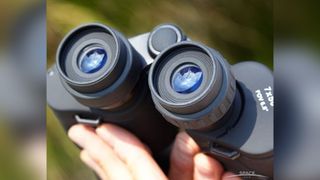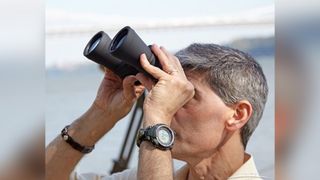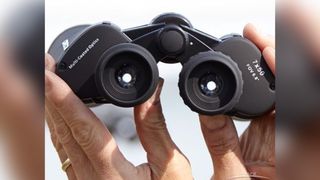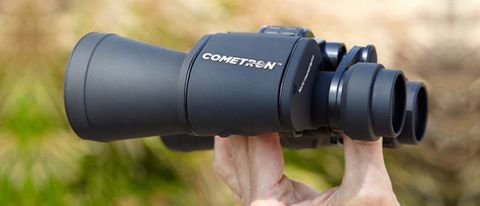Space Verdict
Frankly, we expected to laugh at these binoculars. Instead, we ended up loving them for what they are. If you are looking for a very inexpensive entry to the joy of binocular skywatching, you can't do much better than Celestron's Cometron 7x50.
Pros
- +
Wide field of view
- +
Good optics at a great price
- +
BK7 glass
Cons
- -
Not drop-proof
- -
Water-resistant only
Why you can trust Space.com
As a first binocular for young astronomers, the Celestron Cometron 7x50 binoculars excel. As a grab 'n' go, "don't really care if they get trashed," second set of binoculars for adults, the Cometrons are without equal.
Magnification: 7x
Objective lens diameter: 50mm
Angular field of view: 6.8 degrees
Eye relief: 13mm
Weight: 1 lb, 11 oz
The Cometron 7x50 and its big sister, the 12x70s, appeared in July 2013, 10 months after the discovery of Comet ISON, which was predicted to graze the sun on Nov. 28, 2013. Had ISON survived its close-up with our star, it might have made for spectacular viewing during the holiday season. The Cometron name, a solid marketing idea, would have been fortuitous. But, alas, Comet ISON never became large enough to see very well through Cometrons. It was ripped apart by titanic gravitational forces a few hours before it even reached its closest encounter with the sun ('perihelion').
Celestron Cometron 7x50 binoculars best price today:
Bag this excellent Porro design binocular today and get this pair of porro BK7 binoculars at their best price online.
Celestron Cometron 7x50: Design
- Water-resistant (not waterproof)
- Porro design ideal for astronomy
- BK7 glass is good but not great

Celestron claims only that the Cometrons are water-resistant, not waterproof. The body components are (minimally) rubberized. But that skin ends well before visible joints between body parts — suspect points for liquid entry. This is one of many trade-offs allowing Celestron to bring you (or your favorite youngster) good optics at a great price.
The prisms are of the Porro design preferred for astronomy. But they are cast of the slightly cheaper BK7 glass. All other binoculars we reviewed are BAK4. We saw the difference easily when comparing the exit pupil of the high-quality Oberwerk 8x40 (BAK4) to that produced by this Celestron 7x50. Instead of the sharply defined disc of light projected by the Oberwerks, the Cometrons yielded a fuzzy pseudo-circle, which hardened inward to a diamond-shaped (slightly stretched, rotated square) point on top. The exit pupil is the disc of virtual image at the binoculars' focus point. It’s the circle that you actually look into.)
Celestron Cometron 7x50: Functionality
- Exit pupil is more than 7mm across
- Smart field of view play through manufacturing adjustments
- Ideal for use by adults and kids alike

In practical use, this means you must orient your eyes to look further into the image circlets on the Cometrons than you would on comparable binoculars made with the higher quality BAK4 glass. But, perhaps to compensate, Celestron's designers have chosen an optical geometry that makes a larger diameter exit pupil. It's more than 7mm across; unusually large. So the practical working area of the exit pupil works out to be about the same. This offers a clear example of how optical designers can play with variables of material, processing and design to optimize their results at the desired price point.
The large exit pupil also serves (what we're assuming is) the intended kid market. Young folks' eyes are more elastic; their pupils can dilate wider than the pupils of us old fossils. This lets kids see better in the dark and grow dark-adapted faster (offsetting shorter attention spans!). The Cometrons' wider exit pupil is a better fit for young eyes.
Celestron Cometron 7x50: Performance
- Roll-down eye cups give adjustments for spectacles-wearers
- Useful for other subjects in the daytime
- Dust caps have no retainer cords

A wide dome of starscape awaits you in the virtual image of that exit pupil, letting you or your child get that 'suspended in the sky' feeling.
If you or your young user wears glasses (especially for nearsightedness), the relatively short 13mm eye relief may clamp your ability to see the full visual field. When we mention eye relief, we're talking about the distance from the eyepiece lens' surface to the last spot where a full width image can be seen. Roll down the rubber eyecups and you can get closer, but you'll get more stray light across your glasses and eyes. And your eyeglass lenses my kiss your binoculars' lenses — no harm as long as they don't crash.
Of course, your family can use these binoculars in the daytime for sports and nature watching. Just don't get too close to your target. Cometrons are, after all, optimized to watch objects at the distance of comets. They won't focus on, say, a bird nesting closer to you than about 30 feet.
As with most inexpensive binos, the dust caps have no fixtures for retainer cords. Which means that when kids are using them, these caps might stray far from their lenses by the end of the first night of use without diligent parental accessory-wrangling.
Should you buy the Celestron Cometron 7x50 binoculars?
The Celestron Cometron 7x50 binoculars' small size and light weight (1 lb 11 oz) let you use them all day, yet you can still hand-hold them comfortably after sunset and long into your dark night of sky-watching. Ideal as an inexpensive second pair for adults, or an option for the younger skywatcher it's hard to beat this pair at this price. However, it's worth noting that if image quality if what you're after, the BK7 glass does let this pair down slightly and star gazers would be better off heading for a pair with BaK-4 glass. Though, Celestron does counteract this with the generous exit pupil.
If the Celestron Cometron 7x50 isn't for you
If you're looking for a pair of well-priced binoculars for kids we think you can't beat the Celestron Cometron 7x50s, that's why they top our list of the best binoculars for kids. But for those that want to take a step up in image-quality we'd advise taking a look at the Celestron Nature DX 8x32 binoculars as they have BaK-4 glass but are still affordable all-rounders.
Want the best binoculars overall? Then that title would go to the Canon 10x42L IS WP binoculars which we've given a perfect score of five stars in our best binoculars buying guide. There's plenty of eye relief (perfect for spectacles-wearers), they have a rugged build quality and they even feature in-built optical image stabilization.
Join our Space Forums to keep talking space on the latest missions, night sky and more! And if you have a news tip, correction or comment, let us know at: community@space.com.
Dave Brody has been a writer and Executive Producer at SPACE.com since January 2000. He created and hosted space science video for Starry Night astronomy software, Orion Telescopes and SPACE.com TV. A career space documentarian and journalist, Brody was the Supervising Producer of the long running Inside Space news magazine television program on SYFY. Follow Dave on Twitter @DavidSkyBrody.
- Jase Parnell-BrookesChannel Editor


